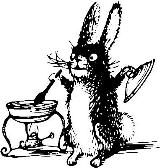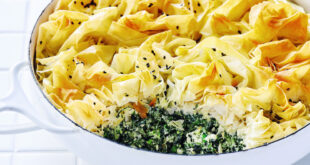Urban Kiwis are a funny bunch. They are quite happy to tuck into spring lamb which, but a short while ago, was frolicking in the paddock and would not give a second thought to the beast that was the source of a nice piece of organic veal but offer rabbit and everything changes. Childhood memories of hutches of Flopsies, Mopsies and Cotton-tails or visions of fluffy Easter Bunnies flood their minds and they choose something else to eat and in doing so pass on one of the most nutritious meats available.
Wild rabbit meat has fewer than half the calories of pork and about half those of lamb and beef. It contains approximately 8g of total fat per 100g; that is less than pork, beef, lamb, turkey, veal or chicken, together with a higher percentage of protein than any of them. Rabbit meat is high in vitamins B6, B12 and Niacin and is a good source of Iron, Phosphorus and Selenium whilst being low in Sodium. It is quite high in cholesterol however but with about 82mg per 100g rabbit meat has less than pork, beef and even chicken.
Delicious and nutritious though these animals undoubtedly are, they are also a major pest. Rabbits compete with stock for grazing, often eating out the most palatable grass together with clover and the buds and seeds of many annuals and their habit of eating grass leaves right down to the ground seriously damages the future productivity of pasture. In softer soils their burrowing causes serious erosion. One of the biggest problems is that with a female rabbit able to produce up to 40 young in a year, who in turn are able to breed within 3-4 months, there are just so many of them. Many measures have been tried to deal with them but how good it would be if one day a way was found of turning farming's curse into a bountiful source of inexpensive and healthy food.
I bought some wild rabbit the other day at a budget-breaking $32 a kilo so I decided I'd think carefully about what to do with it. I like the idea of farmhouse recipes for rabbit and with a love of garlic my first thought was an old Spanish one.
Conejo Al Ajillo
1 rabbit
50ml white wine or sherry vinegar
1 tbsp plain flour
Sea salt and freshly ground black pepper
1 large head of garlic – the cloves peeled and roughly chopped
150ml good olive oil
150ml dry sherry or dry white wine
The night before cooking it, cut the rabbit into about 12 pieces and put them into a ceramic, glass or stainless steel bowl. Sprinkle with the vinegar and leave it overnight to marinate.
The next day dry the rabbit thoroughly then roll the pieces in the flour which has been seasoned with salt and pepper. Heat the olive oil in a shallow pan over a medium heat and when hot fry the rabbit pieces until just golden. Add the chopped garlic and continue frying for 30 seconds then add the wine or sherry and allow to bubble for a moment or two. Reduce the heat and cover the pan and allow to cook for 30-40 minutes or until the rabbit is tender and the liquid almost evaporated. Serve the rabbit in its juices with crusty bread and a salad.
Serves 3-4.
Another marvellous Mediterranean method that I enjoy is the Italian hunter's rabbit.
Coniglio Cacciatore
3 tbsp good olive oil
1.5kg rabbit – cut into 8 pieces
Sea salt and freshly ground black pepper
6 cloves of garlic – crushed and finely chopped
1 tin of chopped Italian tomatoes in juice
300ml dry white wine
2 tbsp each of chopped fresh oregano and thyme
1 tbsp chopped fresh rosemary
Chopped fresh parsley for garnish
Heat the olive oil over a high heat in large heavy casserole. Season the rabbit pieces with salt and pepper then add them to the hot oil and brown them on all sides. Add the garlic and continue to cook for another minute. Pour in the tomatoes and the wine and bring to a boil while deglazing the pan. Reduce the heat to medium and cover. Simmer for about 30 minutes or until the rabbit is cooked. Remove the rabbit to a plate and add the chopped oregano, thyme and rosemary to the pot. Simmer for 5 or so minutes to reduce the sauce then return the rabbit to the pot. Heat through then check seasoning and serve garnished with chopped parsley. It can be served with plain pasta, rice or simply crusty bread and a crisp salad.
Serves 4.
Rabbit is often cooked with Dijon mustard and is divine with a little blue cheese.
Lapin Dijonnais ma Façon
8 rabbit joints
4 ½ tbsp Dijon mustard
Plain flour seasoned with salt and freshly ground black pepper
85g unsalted butter – roughly chopped
5 rashers of streaky bacon
1 large onion – chopped
3 cloves of garlic – finely chopped (more if desired)
350ml cream
75-100g good blue cheese – crumbled
Chopped chives for garnish
The night before cooking, wash and carefully dry the rabbit joints. Then coat them evenly with the mustard and leave in a cold place overnight.
The next day lightly dust the rabbit with seasoned flour, melt the butter in a heavy casserole and brown the rabbit on all sides. Remove them from the pot and set aside. Into the pot put the chopped bacon and cook for 4 minutes or so then reducing the heat to low, add the onion and garlic and cook until the onion is soft. Return the rabbit to the pan; cover and cook over a very low heat for another 30 minutes. Meanwhile preheat the oven to 180˚C. Remove the pot from the heat and stir in the cream. Cover and cook in the oven for about 45 minutes, stirring from time to time. Five minutes before the end of cooking, gently stir in the blue cheese. Serve garnished with the chives and with steamed new potatoes and whole French green bean.
Serves a hungry 4.
Or I could make a paté or rillettes or a pie or a soup or even a bunnyburger… or I could just sit and enjoy thinking about it for a while longer.
Oh, and by the way, if any of you still can't bring yourselves to eat the cast of Watership Down, all the above recipes are good using chicken instead.











Join the Discussion
Type out your comment here:
You must be logged in to post a comment.